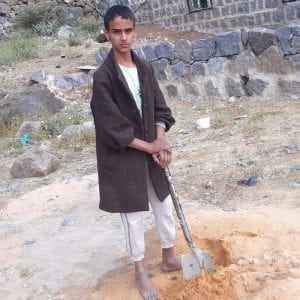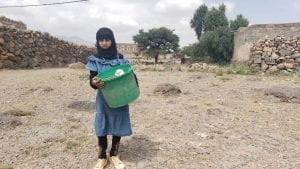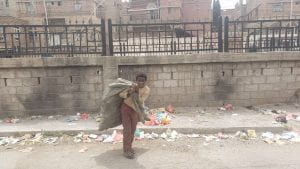Child-labor’s frightening growth during the war in Yemen
by Ahmed Aldali and Abdusalam Almassajdi
Sana’a, Yemen November, 5 2021
(Translated from the Arabic by University of Oregon Professor David Hollenberg, January 17, 2022. The children’s surnames are omitted to exercise abundant caution for their security.)
The war in Yemen has been raging for almost 7 years. The failure of any military solution or diplomacy brokered by the United Nations to end the conflict, economic decline, and the collapse of the country’s health and educational systems has led to a commensurate rise in poverty and unemployment, and an unprecedented increase in the numbers of migrants.
Foremost on the list of victims of this crisis are the children of Yemen, the most vulnerable population in all wars and struggles. There has been an abrupt, frightening increase in the number of children who have been forced to stop their education and join the work force.
Official statistics (which are approximate) claim that the war has driven more than 400,000 children to leave their schools and work at an early age–ranging between 5 and 17 years old. This increase is a result of the conflict in Yemen and its consequences, including the displacement of more than four million persons who can be found in more than 1,500 temporary camps who rely on emergency support to sustain their lives.
UNESCO reports that 11.3 million children in Yemen are in need of humanitarian aid for protection in the present conditions which, in its estimation, represents a state of emergency as acute poverty grows; the situation requires an international movement to offer assistance.
Similarly, UNICEF has gathered abundant evidence that nearly half the residents of Yemen in 2014 were living under the poverty line; their recent reports clarify that at present, the rate of national poverty has risen to nearly 80 percent—that is, eight of every ten children are in families without sufficient income to secure their basic necessities.
In light of this, the local organization A Shield for the Protection of Children (Siyāj li-himayat al-atfal) says that the percentage of children working in Yemen during the period of the war possibly exceeds four times what it was in 2014– a frightening percentage that portends economic and security disasters in the present and near future.
The Shield projects a growth in this percentage for numerous reasons, foremost among them, the economic collapse which Yemen is witnessing resulting from the war. This has led to the stoppage of payment of salaries of the educated and government workers, and the closing of many small and mid-sized local associations and organizations. These factors both add to the poverty and lower the level of consciousness regarding the growth of child-labor and its dangerous effects on Yemen’s youth.
Muath (refuge) age 13: He has not found refuge from suffering
Muath, who will be 13 in the spring, works as an assistant with one of the relatives of his mother in the work of digging, debris management, construction, and the laying of concrete-cement posts. He does the work of carrying stones and the materials for building. He returns late at night carrying in his pocket change to sustain his family—four brothers, a mother, and his father whom the war drove to unemployment after his salary ceased 35 months ago in light of the transfer of the central Yemeni bank from Sana’a to ‘Aden.
Muath did not know that the war would steal his capacity to enjoy a safe childhood and prevent him from exercising his right to education. Yet he found himself forced to leave his classroom and struggle to seek out work opportunities to survive. He is similar to one of thousands of Yemeni children who fill the streets and neighborhoods of the capital Sana’a and the rest of Yemen’s provinces.
Muath says that the decline in his family’s capacity to meet their basic needs results from the stoppage of their lone source of income, that of his father who was working as a soldier in the security force. His mother suffers from chronic illness. The family’s needs have forced him to do this exceedingly difficult work despite the hazard to his own frail body.
Muath’s mother says that she is not pleased that her small child is working. But the decline in living conditions in the county and the stoppage of her husband’s salary from being paid for the fifth year has forced them to accept and submit to this state of affairs.
She adds with weariness and pain: “I am anxious about my boy’s future; he is being lost before my eyes—he was forced to leave school with no plans to return and thus is unable to acquire his education since we have become dependent on him as our primary source of income for household necessities and the medication that I require all month.”
There is no sign that a political solution is close in Yemen in light of the failure of the international community and attempts of the United Nations to strike a political solution to end the war in the country. It seems that Muth has no escape but to engage in harsh labor to secure a sufficient means of survival for his family. Returning to school is a dream which he cannot allow to sway him at the present time
There are reports from UNICEF that there are upwards of two million children, boys and girls of school-age, who are not in school because of poverty and lack of opportunity for education in Yemen. This number is more than double the 890,000 children who reportedly did not join or attend schools in 2015.
Bra’a, age 12: pain and hope
In Yemen, child-labor is not restricted to only boys; there are young girls working, among them, Bra’a, who will be twelve in the spring and lives in a village approximately 7 kilometers from the capital Sana’a. Daily, she traverses a distance of 2 kilometers by foot to and from work in the agricultural fields and gardens owned by the farmers in the villages next to hers.
Bra’a says that for three years she has been helping her family, which consists of eight people: five sisters, one brother, and her mother and father who works in the field of education, but has not received his salary since 2016, as is the case for thousands of educated workers in the country. She begins her path to work daily with others who pick and gather potatoes, tomatoes, cucumbers, peaches, prickly pear and other fruits and vegetables, and pack them in plastic crates to be ready for sale before they are transferred to markets.
She adds: “I return at noon every afternoon to study my lessons until I go to school at exactly 1:00 pm. Later, I return to my mother and siblings for house-work and then I am exhausted and go to bed early in order to wake at the appointed time.”
For Bra’a, completion of half a crate of potatoes requires her to work seven hours continuously; this taxing labor yields a value of 2,000 Yemeni Riyals ($2 USD). She then presents this income her father so that he can buy necessary goods for the house, in addition to its covering a fraction of costs and expenses of school and her four sisters.
Bra’a’s daily routine is free of comfort, play, and appropriate recreational activities or cultural life—a right for children as stipulated by ordinance 32 of the United Nations for the agreement on the established rights of the child established in November, 1989, and which Yemen co-signed in 1991.
Despite Bra’a’s undeserved suffering and parting from the normal life of a child at an early age, she has a strong resolve to complete her education. She hopes to become either a noteworthy media figure, or a famous doctor in the future. To achieve this ambition, she is careful to have her studies parallel her time committed to the care of her family in acquiring the basic necessities and household needs despite the difficulties and challenges she faces. And so, she is prevented from what is due her: time to play with her friends in the neighborhood.
It is estimated by UNICEF that are 1.8 million children throughout all parts of Yemen are in need of emergency educational assistance. This number represents a large growth in comparison with the 1.1 million who have been reported on their needs in December 2014 before the outbreak of the war.
Muhammad, age 14: Unending suffering and unbearable deprivation
Muhammad, who will be 14 in the fall, sits in a wretched spot. His face is emaciated, his head, heavy with cares, his eyes immersed in sadness, the weight of the world on his shoulders. His childhood has been stolen, and he is not able to live in safety, unable to take care of himself while in a state of destitution, forgotten, subject to suffering and neglect after he found himself alone facing a bitter reality.
Muhammad could be most of the Yemeni children harmed from this war who have been robbed him of a safe childhood and prevented from education. For Muhammad, the war’s damage was extensive, immediate and harsh: His father was killed when his truck, in which he was working to haul goods from the ports of Aden and Hudaydah to the capital Sana’a and all the Yemeni provinces, was struck by a coalition air-craft, robbing Muhammad of a father. This was six years ago when Muhammad was still an 8-year-old child.
Muhammad’s mother and sister, who is one year older, live in a modest home in the village of Masajid west of the capital Sana’a in north Yemen. They struggle because of the impoverishment of his family in which he has become the sole provider after the war forced him to leave school and face the work-lines. Muhammad’s choice was to either to leave his classroom seat without return or continue his education and risk death from hunger to his home. Muhammad partners with friends in the village to make a living in these harsh conditions. He works in many tasks, among them, those arduous and exhausting for a youth under 18, such as work in the fields, demolition, construction, making fences, and other work such as standing guard, or sowing fields in his region, as well as extremely taxing work such as carrying rocks and hauling construction materials and loading and unloading goods for shipping.
Muhammad’s mother spoke to us. She said, “It is regrettable that the conditions imposed by the war led to my son engaging in the market-place even as we only purchase the bare necessities for two years. He gathered the expenses for school for his only sister since we were beset by a threat to our capacity to survive.”
Muhammad is not the only child in Yemen who is compelled to sacrifice his education to take care of his family. On the contrary, his situation can be extended to hundreds of thousands of children whose education has been affected as a consequence of the horrific, continuing conflict for years, and who have been exposed to several types of deprivation, exploitation, as well as physical and psychological damage in recent times as result of the outbreak of the Covid 19 coronavirus. The virus has inflicted a great amount of suffering on the children of Yemen during the past years of the war.
UNICEF has expressed increasing concern regarding children who are not assigned schools or who have abandoned their schools in order to work in the recent past and that they might not return to their studies at all if they are not provided the correct form of support.
Activists and rights-workers warn that the rise of the percentage of child labor in Yemen resulting from the continuation of war, the rise in internal displacement in hot spots, the decline of economic activity, the rise in prices, the decline in the local currency, the pay-stoppage to government workers, and the lack of food and medicine. All these factors make it certain that the future of children in Yemen is endangered by their being compelled to leave their education and abandon their schools at an early age.
Ahmed Aldali and Abdusalam Almassajdi are freelance journalists based in Sanaa.




